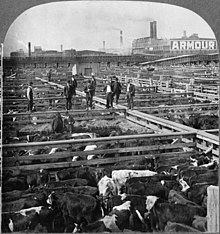The Jungle
The Jungle is a novel by American author and muckraking-journalist Upton Sinclair, known for his efforts to expose corruption in government and business in the early 20th century.
[1] In 1904, Sinclair spent seven weeks gathering information while working incognito in the meatpacking plants of the Union Stock Yards in Chicago for the socialist newspaper Appeal to Reason, which published his novel in serial form in 1905.
[2] The book realistically depicts working-class poverty, immigrant struggle, lack of social support or welfare, harsh living and dangerous working conditions, generating hopelessness or cynicism and cruelty among the powerless.
A review by Sinclair's contemporary, writer Jack London, compared The Jungle to America's most famous novel written to expose a cruel system, by calling it "the Uncle Tom's Cabin of wage slavery.
They and their extended family have recently immigrated to Chicago due to financial hardship in Lithuania (then part of the Russian Empire).
The women of the family answer an ad for a four-room house; Ona, who came from an educated background, figures that they could easily afford it with the jobs that Jurgis, proud Marija, and ambitious Jonas have gotten.
However, with the help of an old Lithuanian neighbor, they discover several unexpected expenses in the contract that they must pay every month on time, or else face eviction—the fate of most home buyers in the neighborhood.
Some levity is brought to their lives by the arrival of a musician, named Tamoszius, who courts Marija, and the birth of Jurgis and Ona's first child.
Amid this hardship, Jonas deserts the family, leaving them no choice but to send two children to work as newspaper boys.
Ona eventually confesses that her boss, Phil Connor raped her, after which, by threatening to fire and blacklist everyone in her family, he managed to coerce her into a continuing sexual relationship.
While begging, he chances upon an eccentric rich drunk—the son of the owner of the first factory where Jurgis had worked—who entertains him for the night in his luxurious mansion and gives him a one-hundred-dollar bill (worth the equivalent of about $3,500 as of October of 2024).
Jurgis helps Duane mug a well-off man; his split of the loot is worth over twenty times a day's wages from his first job.
[9] All works published in the United States before 1924 are in the public domain,[10] so there are free copies of the book available on websites such as Project Gutenberg[11] and Wikisource.
This version was edited by Gene Degruson of Pittsburg State University, based on a correspondence regarding the novel found in the basement of a farm in Girard, Kansas.
[15] He intended to expose "the inferno of exploitation [of the typical American factory worker at the turn of the 20th Century]",[16] but the reading public fixated on food safety as the novel's most pressing issue.
[16] Sinclair's account of workers falling into rendering tanks and being ground along with animal parts into "Durham's Pure Leaf Lard" gripped the public.
The poor working conditions, and exploitation of children and women along with men, were taken to expose the corruption in meat packing factories.
[19] He wrote privately to journalist William Allen White, expressing doubts about the accuracy of Sinclair's claims: "I have an utter contempt for him.
"[21] He assigned the Labor Commissioner Charles P. Neill and social worker James Bronson Reynolds to go to Chicago to investigate some meat packing facilities.
Learning about the visit, owners had their workers thoroughly clean the factories prior to the inspection, but Neill and Reynolds were still revolted by the conditions.
Their oral report to Roosevelt supported much of what Sinclair portrayed in the novel, excepting the claim of workers falling into rendering vats.
"[23] That year, the Bureau of Animal Industry issued a report rejecting Sinclair's most severe allegations, characterizing them as "intentionally misleading and false", "willful and deliberate misrepresentations of fact", and "utter absurdity".
[29] Saint Joan of the Stockyards is a play set in Chicago written by the German modernist playwright Bertolt Brecht between 1929 and 1931, after the success of his musical The Threepenny Opera and during the period of his radical experimental work with the Lehrstücke.
[30][31] In July 2019, Penguin Random House's Ten Speed Graphic imprint published a version of the story, adapted and illustrated by Kristina Gehrmann and translated by Ivanka Hahnenberger.



